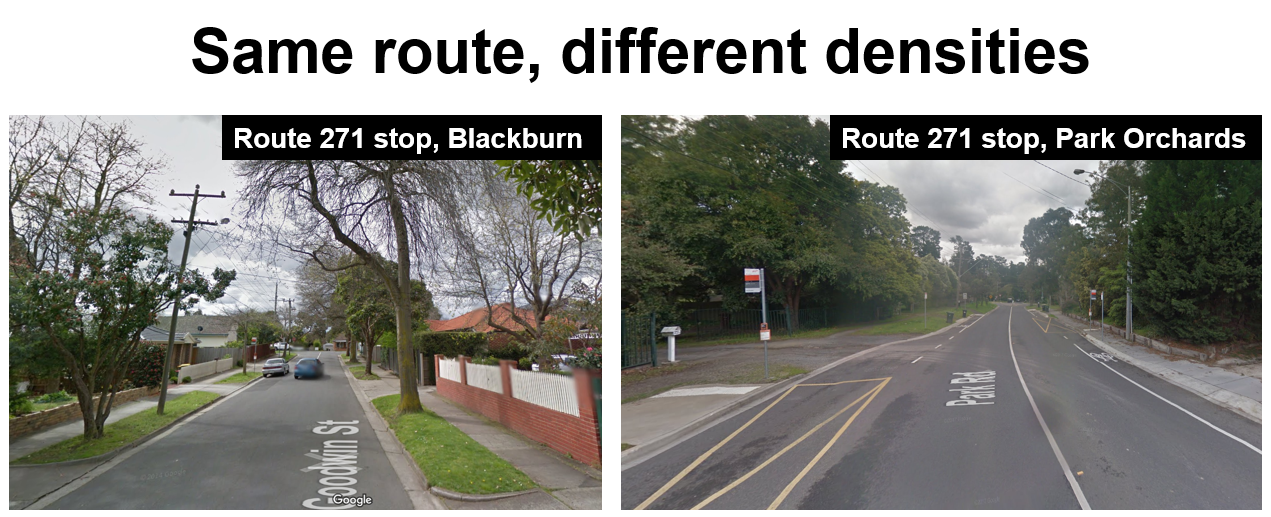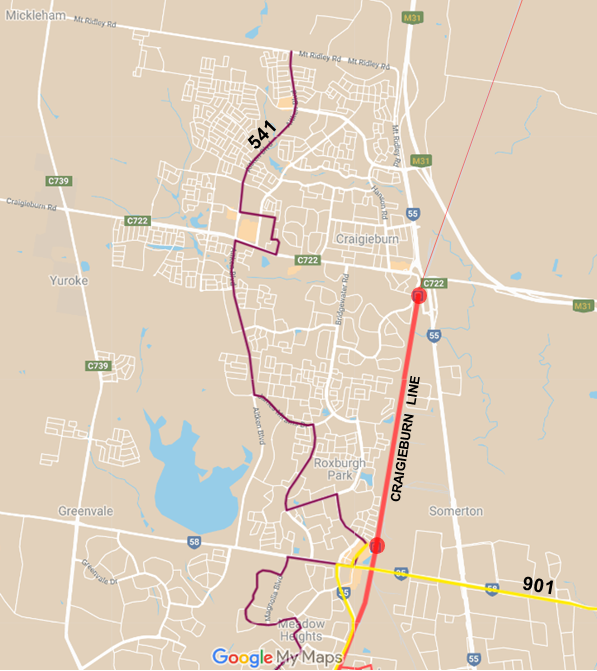Last week we looked at Route 624 between Kew and Oakleigh. It wasn't easy to describe because it was really three or four routes in one.
Today's route, the 271, is a bit like that. Operating from Box Hill to Ringwood it passes through a large area of normal suburban density near Box Hill, Blackburn and Mitcham before taking off into the greenery around Park Orchards. It then heads south again, via Ringwood North, to its Ringwood terminus. It starts in the electoral district of Box Hill (represented by Paul Hamer MP), then runs through Warrandyte (Ryan Smith MP), ending in Ringwood (Dustin Halse MP).
It's the khaki line on the joined up local network map below (Visit PTV for the individual local government area maps at a better scale). It's probably easiest to follow from Park Orchards in the northernmost tab of the map.
The photos below show two parts of 271's catchment. Left is a residential street in Blackburn. It's at close to normal densities for what is now middle-suburbia. 600 to 900m2 would be a fairly normal block size. However population ageing in some middle areas has lowered population density compared to when there were more children in the neighbourhood. On the right is Park Orchards. Its big selling point is large 'lifestyle' blocks within driving distance of jobs in the eastern suburbs and even Melbourne CBD. You'd need to be wealthy to buy a house here. And it would be rare for homes not to have at least one car per adult.
Not photographed is the western part of 271 along Whitehorse Rd. It has some commercial land uses. These include jobs that the route may usefully serve. Although the catchment doesn't look particularly productive (as it parallels a well-served rail line and there are other bus routes nearby) the Box Hill destination is convenient for a wide range of work, shopping, education and health trips.
Knowing catchments is important because different neighbourhoods generate different levels of usage for public transport. A service level appropriate in one area may be too much or too little in another. With the large variations along it may be difficult working out what service level is right for 271. More on that next when we discuss the timetable.
Timetable
Below is Route 271's timetable.
Buses run approximately every 30 minutes, from morning to night, with a 20 to 25 minute headway during some peak times. A more even 20 minute service runs during the afternoon school peak but only covers the early part of the commuter peak, with the 30 minute service resuming at 5pm from Box Hill. The Ringwood end has a better peak service, with the 20 minute frequency continuing until 6pm. However even this does not fully cover the pm peak, with city commuters needing to finish not much after 5pm to still enjoy the 20 minute frequency.
The half-hourly schedule continues until 9:30pm - better than average for a Melbourne local bus route. Also superior is the weekday finish time with last trips in both directions departing at 10:30pm. Only SmartBuses and a handful of ex-Met bus routes (including 271) are still running this late.
Similar to weekday service, Saturday service is every half hour. This makes it similar to the (sometimes overcrowded) SmartBuses on dense busy corridors like Route 900 (Caulfield - Chadstone - Oakleigh - Monash - Rowville). However 271's 8pm finish time is earlier than 'minimum standards' for local bus routes.
This is because Route 271 can trace its history to National Bus routes, which were mostly omitted from getting 'minimum standards' upgrades that many other routes received in the 2006 - 2010 period. For the same reason Route 271 does not run on Sunday, despite its (arguably excessive) Saturday frequency. The route's last major restructure and timetable change occurred in 2014 as part of that year's Transdev network reforms.
Conclusion
What would you do with Route 271? Does it overlap too many routes at the Box Hill end? Is it too indirect? And should some Saturday trips be moved to Sunday to provide an hourly service on each that might better match demand on both days? If you have ideas please leave your comments below.
See other Timetable Tuesday items here
See other Timetable Tuesday items here

































